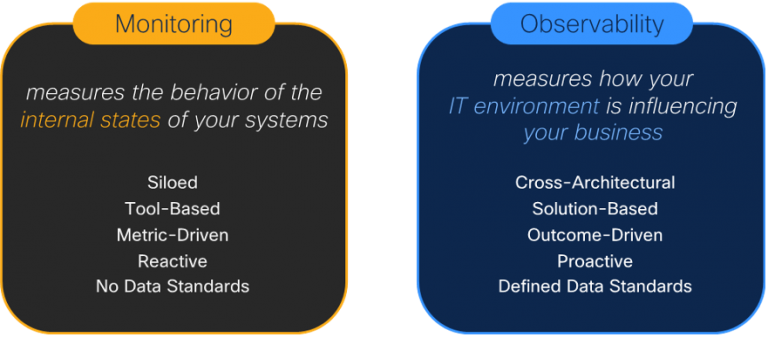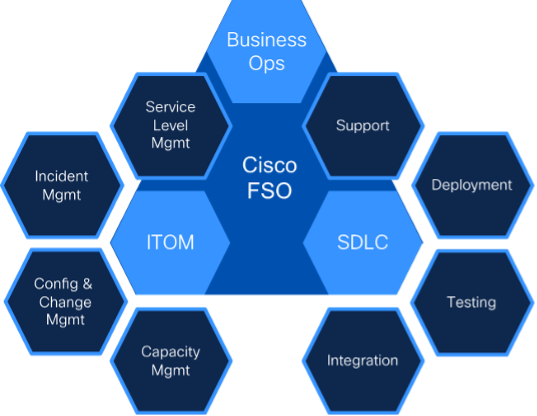In the rapidly evolving world of technology, staying ahead of the game is crucial for businesses. As organizations strive to optimize their IT operations and ensure smooth business outcomes, observability has become a critical capability for IT – but one that can be complex and poorly understood. Cisco is set to reshape the observability landscape with its new Cisco Observability Platform. The Cisco Observability Platform empowers Cisco partners to not only build unique observability offers, but to complement and enhance existing IT Service Management (ITSM), IT Operations Management (ITOM), and Software Development Lifecycle (SDLC) offers.

Observability goes beyond traditional monitoring approaches. While monitoring focuses on specific metrics of individual systems, observability takes an outside-in approach, looking at the holistic impact of an IT environment on business outcomes. It measures how well the systems work together to achieve the desired result, rather than just monitoring their individual performances. Observability enables proactive measures to optimize business outcomes by correlating and analyzing the data collected from various domains across different service layers.
The Core Elements of Observability
The core elements of observability include Application Performance Monitoring (APM), IT infrastructure monitoring (ITIM), and security.
APM covers a wide range of capabilities, from analyzing code modules and databases to monitoring user experiences. ITIM spans physical, virtual, and cloud infrastructures, including servers, storage, and networks. Security intersects both infrastructure and applications, encompassing a range of capabilities from firewalls to runtime application security protection.
The Challenges of Monolithic Observability Solutions
The first generation of observability solutions on the market today have adopted a monolithic approach, attempting to excel in all of these domains. This is typical of first-generation solutions. However, the complexity of the observability landscape and the diversity of platforms and tools available render a monolithic approach inefficient and unscalable. As businesses seek to incorporate additional domains into their observability strategies, the limitations of monolithic solutions become even more apparent.
Customers will realize the full value potential of observability when observability is integrated into the wider IT Operations Management (ITOM) landscape, transforming core operational processes such as incident management, service level management, and capacity planning and forecasting. Applications operations teams also utilize observability to enhance Software Development Lifecycle Management (SDLC) processes, integrating observability with CI/CD. Lastly, observability should incorporate business context and align with the business’ operational KPIs.

To achieve this, the observability solution must easily integrate with adjacent ITSM and ITOM platforms and tools – and crucially, these integrations must be profitable and commercially sustainable for Systems Integraters and VARs.
Cisco Observability Platform is a New Approach
The Cisco Observability Platform is a major step forward from the vendor-centric, complex, hard-to-integrate observability solutions that dominate the market today, to an open, standards-based, “plug and play” architecture.
The platform serves as a centralized hub to collect, enrich, and analyze observability data from multiple domains. It provides four key capabilities:
- Ingestion: Integration of telemetry from any service that implements an OpenTelemetry interface, from cloud services, and via user-defined REST interfaces
- Modeling: The ability to define bespoke data models that align with the customer’s service delivery and operations environment
- Enrichment: Telemetry data transformation, correlation, and analysis to accelerate and automate anomaly detection and root cause analysis
- Integration: A powerful built-in UX framework and a Unified Query Language that simplifies integration with reporting, visualization, workflow, automation, and other ITSM/ITOM platforms
Cisco Observability Platform is Built on Open Standards
The Cisco Observability Platform leverages OpenTelemetry to enable businesses to effortlessly integrate, correlate, and analyze full-stack telemetry to gain a holistic view of their environment’s impact on business outcomes. OpenTelemetry provides the tools, development kits, APIs, and protocols that define how observability data is collected, formatted, and transported. OpenTelemetry’s rapid adoption as the industry standard further solidifies its ability to enable comprehensive observability solutions.
Cisco Observability Platform is Partner-Centric
Our go-to-market strategy for Cisco FSO Platform focuses on empowering partners to create custom solutions aligned with their customers’ unique business outcomes.
Cisco Observability Platform provides VARs, SIs, and MSPs with multiple ways to build unique, differentiated offers:
- Leveraging Cisco-built and partner-built applications and modules via the FSO Exchange marketplace.
- Developing and enriching data models, data transformation, and data analysis for individual customers.
- Integrating FSO Platform with the customer’s other ITSM/ITOM platforms to enable operational transformation.
- Building and reselling their own applications and modules that run on Cisco Observability Platform.
Offers based on the Cisco Observability Platform can expand the partner’s strategic relevance and business impact, and provide value-based differentiation for both professional and managed services.


CONNECT WITH US